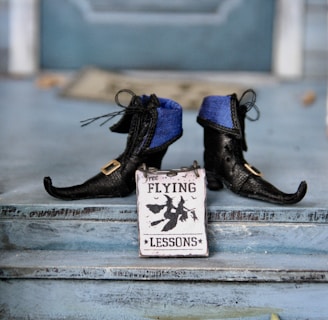FLYING headfirst into All THINGS MAGICAL with a sense of curiosity, humor, and just a touch of skepticism
Why Do Witches Wear Pointy Hats and Shoes? The (Mostly) True Story
When you think of a witch, what comes to mind? A broomstick, a black cat, and, of course, a pointy hat and curled-up shoes. But how did witches end up rocking these iconic accessories? Did they shop at the medieval equivalent of Hot Topic? Let’s dig into the history and the hilarity behind this witchy fashion statement.
Julie Gish Norris
1/15/20252 min read


The Mysterious Origins of the Pointy Hat
First, let’s tackle the hat. The classic cone-shaped hat associated with witches might have started as practical headgear. In the Middle Ages, tall, pointed hats were worn by different groups, from Mongolian nobility to European peasants. Somewhere along the way, this style went from chic to suspicious.
By the 15th century, anti-Semitism played a dark role in shaping perceptions. Jewish people in Europe were sometimes forced to wear "Judenhüte" or "Jewish hats," which were pointy. When witch trials became all the rage (not the fun kind), some of that discriminatory imagery got tangled up with the portrayal of witches. Boom: the pointy hat became a symbol of someone outside the social norm—and therefore, obviously magical and dangerous.
Others believe the pointy hat’s association with witches may have stemmed from alewives—medieval women who brewed beer. Alewives were often depicted wearing tall hats to stand out in the marketplace. Unfortunately, their brewing skills (and independence) threatened male-dominated guilds, leading to smear campaigns that linked them with witchcraft. So basically, being a woman with skills and a pointy hat? Witch!
(Clark, E. (2020). Fashion and Folklore: The Witch’s Wardrobe. Occult Press and "Medieval Headwear: Hats Through History," Historical Threads (Online Article).)
Those Curly-Toed Shoes
Now, onto the shoes—because witches are nothing if not fashion-forward. Pointy, curled-toe shoes were all the rage in medieval Europe, particularly in the 12th to 15th centuries. Known as "poulaines," these shoes were often ridiculously long, with tips so exaggerated they could double as a backscratcher!
But how did these stylish kicks become witchy? Well, as poulaine popularity faded among the upper classes, the style lingered among the lower classes and performers. Over time, witches in folklore became caricatures of societal outcasts, and the outdated, overly-pointy shoes fit the bill for artists and storytellers crafting their spooky imagery. It’s as if they thought, "What’s scarier than someone with long, impractical footwear?"
("A History of Poulaines and Pointy Shoes," Museum of Footwear (Yes, it’s real!).
The Pop Culture Makeover
Fast forward to the 20th century, and the pointy hat and shoes got a major glow-up. Thanks to Hollywood classics like The Wizard of Oz, witches were solidified as quirky, pointy-hat-wearing villains (or misunderstood fashionistas, depending on your perspective). And those curled shoes? Iconic. Just ask the Wicked Witch of the East, whose ruby-red footwear had Dorothy’s jaw on the floor.
Let’s be honest: the pointy hat and shoes are fun. They’re dramatic, instantly recognizable, and just impractical enough to scream, "I’m magical and don’t care what you think!" Modern witches may not always don the full pointy ensemble, but the aesthetic has endured as a symbol of rebellion, individuality, and a healthy dose of "don’t mess with me."
The history of witch fashion is a wild mix of cultural trends, societal fears, and outright sexism. But one thing is clear: the pointy hat and shoes aren’t going out of style any time soon. Whether you’re brewing potions or slaying at a Halloween party, or out shopping, embrace the pointy look. After all, it’s a timeless classic—and way more comfortable than stilettos.
If you’ve got tips, tricks, or just a good witchy joke, contact me using the form below. I’ll be over here, trying not to set anything on fire (maybe).
Blessed be, or as I like to say, "Stay witchy, my friends!"
Get in touch
STAY IN TOUCH
© 2025. All rights reserved.
WEBSITE POLICIES
Disclaimer:
The content on this blog is for informational and entertainment purposes only. I am not a medical professional, legal advisor, or any other kind of licensed expert. The practices, products, and tips shared here are based on personal experiences and should not be taken as a substitute for professional medical, legal, or financial advice. Always consult a qualified professional for guidance on health, legal, or other serious matters. Your journey is uniquely yours—trust your intuition and make decisions that feel right for you.
